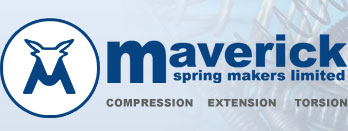Latest Posts
ISO 14001 REGISTRATION
Maverick Spring Makers Limited, a manufacturer of custom springs in Brantford, Ontario, is proud to announce their Environmental Management System has been registered to ISO 14001. ISO 14001 provides a framework for organizations to protect the environment, to identify and control their environmental impact and continually improve their performance in response to changing external and […]
Frequently Asked Questions
So you’ve nearly completed your project, but need one more thing to make it work: a spring. Fortunately, you know Maverick has you covered. When our clients come to us with their spring needs, there are a few things we’ll ask you to ensure the best solution for you in a timely and economical manner. […]
Tags: compression, conical spring designs, extension, fitting a compression spring, hourglass spring designs, installed length of the spring, or torsion, performance and fatigue requirements of the spring, working length of the spring
How to Stop Air Pollution in Canada, U.S.
In our last blog, we took some time to discuss the causes for the increasing level of pollution in the U.S. and Canada. Now that we understand what is filling our air with dangerous and often fatal levels of pollution, we need to look at ways we can mitigate this disaster. As with the creation […]
Tags: canada's renewable energy sources, how to cut air pollution in canada, steps to fixing canada air quality
What Causes Air Pollution?
Hardly a day goes by where we’re not reading about the dangers of air pollution—because it’s growing, and the complications are evident. This scourge of the modern world is being blamed for everything from the rise in asthma rates and cardiovascular disease to poor childhood development. The problem has become so bad that a recent […]
Tags: air pollution in canada 2014, fossil fuels and air pollution in canada, state of canada's air quality
Why is High Speed Production Equipment Right for Custom Spring Manufacturing?
As technology evolves, many industries are impacted by the growing systems and machinery, which spurs endless benefits. In our business, one of the great advantages to the latest and greatest multi-axis spring coilers is the incredible production speeds that are now possible, thanks to a little help from current machine technology. Looking back at the […]
Tags: canada manufacturer of custom spring, custom spring manufacturing in canada, machinery for custom spring manufacturing
Why We’re a ISO/TS 16949 Certified Custom Spring Manufacturer
At Maverick Spring, we have always taken great pride in our commitment to quality. When a customer begins a relationship with us, we understand they trust that our work will meet or exceed all of their expectations—and for this reason, we have taken the extra steps necessary to become ISO/TS 16949:2009 certified. The International Organization […]
Tags: ISO certification for Canadian manufacturer, ISO/TS 16949 Certified Custom Spring Manufacturer, ISO/TS 16949:2000 for custom spring manufacturer canada, QS900 certification for spring manufacturer in canada
Top 5 Stories from the North American International Auto Show 2014
The North American automotive industry has seen its ups and downs. While 2013 was a fantastic year for the big names (15.6 million new passenger cars and light trucks were sold in the U.S. alone), it’s also important to remember we’re only four years removed from the troubles of 2009—but there’s plenty of hope ahead. […]
Tags: Detroit Auto Show new cars, how North American International Auto Show 2014 impacts Canadian automotive industry, New cars from North American International Auto Show 2014, what happened at the detroit auto show
Custom Spring Manufacturing for Cleaner Water
One of the challenges in designing products with springs is figuring out exactly what you need for a spring: You know what you want the spring to do—but what will the spring look like? How big will it be? What material will it be made of? One option involves getting in contact with one of […]
Tags: custom spring manufacturing water filter, custom spring stainless steel type 302, tapp water filter twothirds water, twothirds water filter, zinc plated music wire spring
We Believe in the Family-Owned Business
When we introduced you to the company in a previous blog, we discussed how the founder, John Monné, and his family are still a major part of Maverick Spring Makers. The business began as one idea from Monné, and it has evolved to manufacture custom spring products for North America—and we’ve learned a lot along […]
Tags: benefits of family owned business, canada automotive industry, canada manufacturing, family owned automotive canada, family owned business, family owned businesses in canada, spring makers
Ontario’s Automotive Industry Sees Major Success
Did you know that more cars are manufactured in Ontario than any other area of North America? Yes, this Canadian province beats out its neighbors, Michigan included, when it comes to auto production. With Ontario overtaking Detroit, the motor city, in auto production, that makes a big statement about the province’s place in the auto […]
Tags: automotive industry in canada, canada automotive, canada cars, cars in ontario, maverick spring makers, ontario automotive, spring in automotive, spring makers, springs in cars, state of canada automotive








